AI Art & Lolita Fashion
For those who aren’t aware, Souffle Song has recently come out with an AI art print, and the most recent Royal Princess Alice print was also AI generated. This has caused a bit of a stir, so I wanted to sit down and talk a bit about AI art and lolita.
What is AI Art?
First of all, lets talk about AI art, what it is, and why so many artists are upset about it. AI art is a blanket term used to describe a type of modern text-to-image generator programs on computers. Many of them, like the popular Midjourney, are based on something called Stable Diffusion. Stable Diffusion is a program that takes an image, compresses it and adds noise, aka static or pixelation, to the compressed image until it’s unrecognizable. Then it guesses how much static it used and undoes this process as if it used that much static to get back to an image. After this, some fine tuning is applied to fix things that don’t come out right. (I’m over simplifying this, if you are interested, I recommend the full explanation from Stable Diffusion.) By doing this thousands or millions of times, you can calculate patterns in the images, and these patterns can be used to create images based on the images it learned from that look new and unique, but ultimately are a sort of calculated average of existing images.
I want to be clear, there isn’t really actually anything wrong with this in a vacuum. The problem is where they got all the images they started with. The images that Stable Diffusion used to create this technology comes from LAION-5B. LAION-5B is a set of images and captions that came from the common crawl, which essentially is just like, a saved copy of the internet. The problem is that LAION-5B was created for scientific research, and it’s just a chunk of the internet, and as such it’s full of copyrighted material.
You used to be able to go to Have I Been Trained to see if your images were in LAION-5B, but it’s currently down because researchers discovered that LAION-5B contained heinously illegal content. That said, I can still search for my domain, and it returns the count of images from my blog in the data, which is 301 images.
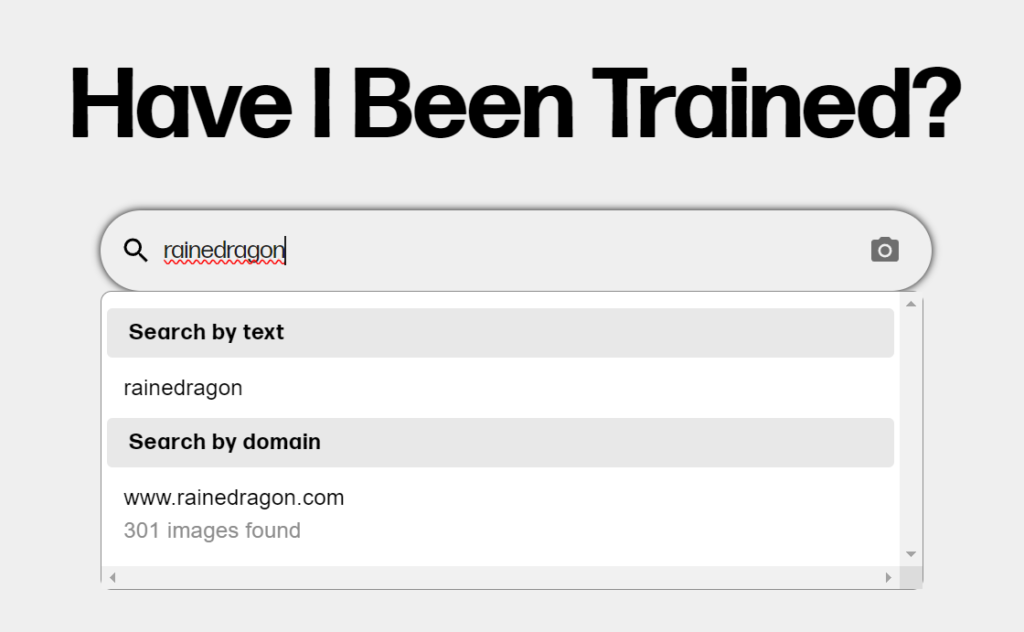
And if you ever used the lolita social media / photo posting site/app Alice Holic, chances are photos of you are in the mix too.
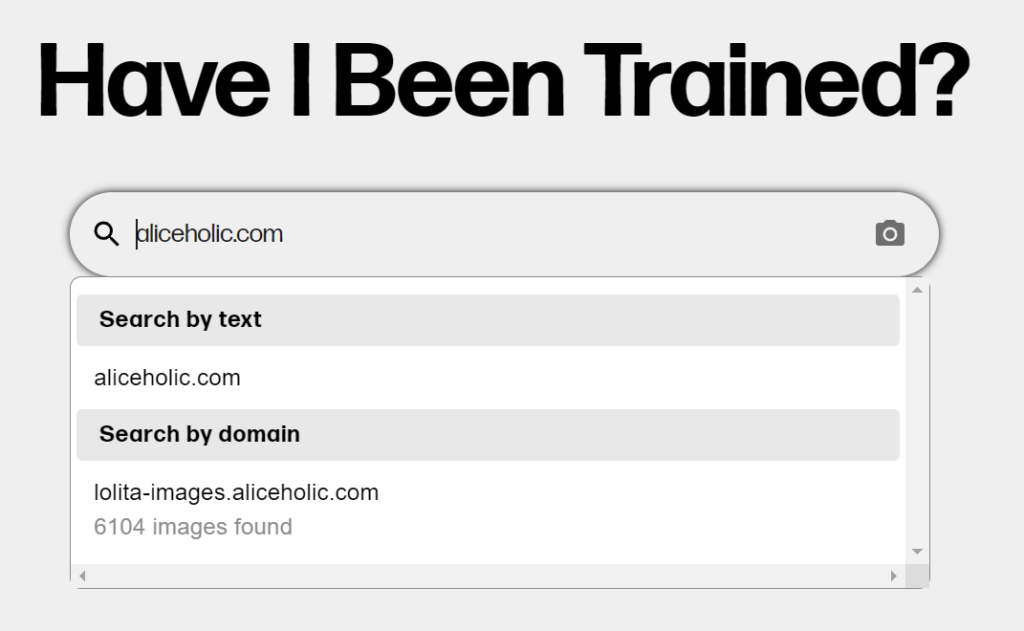
For example, here is an older photo of mine from aliceholic which is in the training data set without my permission (or anyone informing me in any way). I screen capped this back before Have I Been Trained went offline.
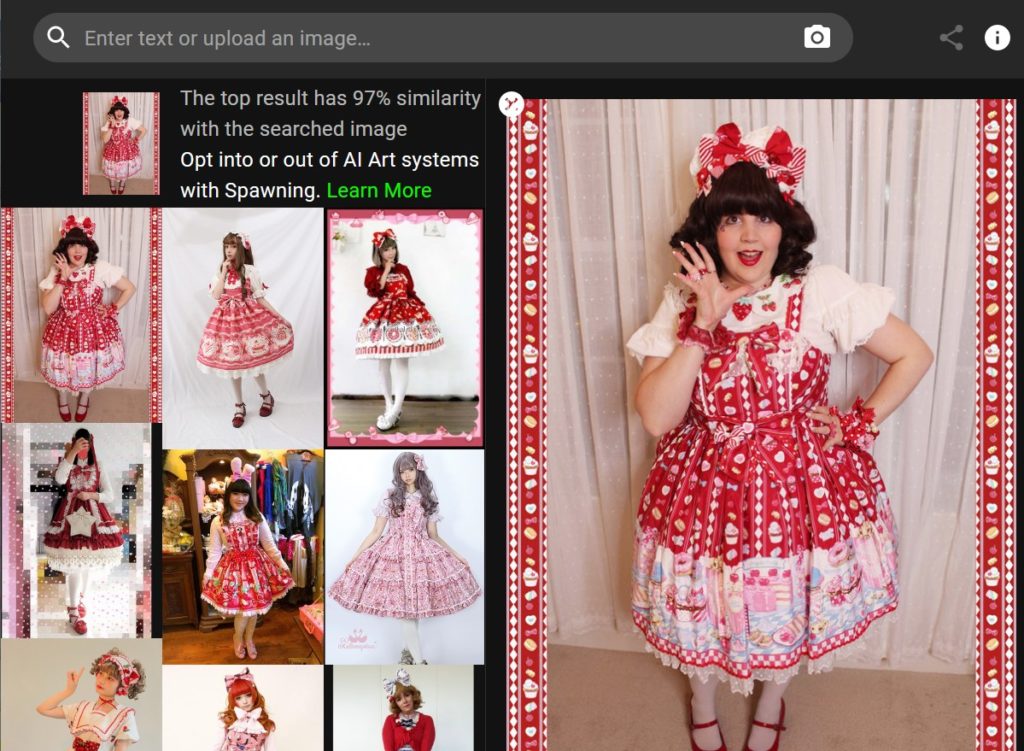
And several other examples of people I recognized, some taken right off of their blogs:



LAION-5B is also known to contain sensitive medical information, CSAM material, and because it is a basically unfiltered chunk of the internet, the data from LAION-5B results in AI image generators that have racial bias.
So, here is the thing. If I go over to something like Midjourney and I ask it for a photo of a sweet lolita, it’s going to create that image based on photos that were scooped up off the internet like the ones above of me, and I think I see Cadney and I think there is some art in there from Claire Benton the creator of pusheen… That’s what it’s going to use.
Now, I work as a web developer, I’ve worked at an advertising agency, and I’ve made and sold stock photos/clipart before. If I wanted to use an image of someone professionally, I would need two things:
1. A signed model release form saying they are OK with me using their face/likeness for whatever I’m using it for commercially.
2. A signed licsencing agreement from the photographer who took the photo.
Without those two things, or some equivalent, you generally can’t use a photo of a person commercially. Stable Diffusion doesn’t have either of those things for any of these people’s faces.
If I wanted to use an illustration, I’d need permission from the artist, same with a photo of something that isn’t a recognizable person.
To add insult to injury, because LAION-5B collected images and captions from around the web at basically random, a lot of the captions contain things like the name of the artist. And if LAION-5B has enough art from the same artist, you can feed an AI image model like Midjourney the name of an artist and it can generate work in their style that looks like they made it. Some artists now have AI art in their style coming up higher in google results than their real work, while other artists have found that AI artwork is way too close to their original work, and searches for some famous artists show Ai fakes instead of their real art in google searches as well, even after google was made aware. MidJourney has also started banning people who speak up about how their latest version is spitting out images that are too close to the training images.
If someone took a bunch of images and licensed them all, or got permission to use them and made an AI image generator, that would be legal and arguably, as long as they used it in an ethical way, it could also be ethical. However, it’s questionable if things based on Stable Diffusion are legal, and IMHO they really aren’t ethical.
Counterfeiting in lolita
In lolita fashion, there is a history of textile prints being ripped off by counterfeiters like Dream of Lolita, K*STAR, Half Cup of Milk shop, OoJia and others.









Lolita fashion brands are very small companies, and the artists usually don’t get paid big bucks for their work, so the lolita fashion subculture in recent years has developed an attitude that is very protective of lolita artists and their work. People who rip off lolita artists are generally not welcome in the community, and the community is generally very quick to condemn this behavior when it pops up.
Designing Without a Print Artist
That said, there are several legitimate ways that a brand can handle not having an artist to make their work. Many brands use clip art and public domain images in their prints. Clip art is stock art you can buy, and the artist gets a cut, and public domain images are images that are so old that they are no longer protected by copyright (usually this is when the artist died more than 70 years ago). For example the ladies and girls in Baby’s Fragrant Rose Memories print are public domain images because they are so old, and a lot of those classic paintings dresses from JetJ use old public domain paintings and a bit of photoshop.




A brand can also pay an artist to collaborate with them, and make them a custom print, or pay to use their existing art. For example, here are a bunch of collaborations. From left to right: Sachiko Matsushita for Melody Basket, nemunoki paper for Morun x Muuna Stoik, Imai Kira for Angelic Pretty, Misaki Kihara for Juliette et Justine, Tani Takuma for Chantilly, Midori Yamada for Vierge Vampur, Sakizo for Baroque, Odani Miyuki for Baby…








These days it’s harder to find a brand that hasn’t done a collab, than to find one that has.
And speaking of one that has, Royal Princess Alice has a really long history of doing collabs. They have collaborated with (in no specific order) Nekosuke, Kopne Awaki, Tono, Spin, Fumika Amenomori, kuua, Tama, Awaki Kobonne, mao, Shirosaki London…. and that’s just this year.










In fact, I could only find 2 previous print releases this year that weren’t collabs and it might just be that I missed the post announcing the collab.
One is “うさネコちゃん”/Usa Neko-Chan/Rabbit Cat, but when I dug deeper, I found tweets connecting the canotier to this collab with Mitsukazu Mihara and lapin labyrinth. It also looks potentially like it could just be photoshopped.






The other print was the にゃいスクリーム/nyuisukuri-mu print, which is a pun on icecream and cats.


This print has a series of icecream cones which are hyper realistic. It’s possible that they are 3D models that were sold as stock photos. It’s also possible that they were AI generated. I can’t really tell.




The more I look at them though, the more I wonder if they aren’t AI. The lemon ice cream has a weird texture on it’s cone. A human wouldn’t texture a model like that, and the lemon sauce at the base is a little bit… weird. So is the single, very plant-like leaf. The cherry one opens like a flower at the top of the cone in a way that cones… don’t. And the lemon one… it’s not got texture from being scooped, it’s got lines of a whitish viscous liquid, like thick squeeze tube mayo on it?
The cats look photoshopped onto the cones, and all use the same cone, but… I’m not convinced that the icecream isn’t AI…
Which brings us to their latest print, the one which is controversial: marie marignantoinette.
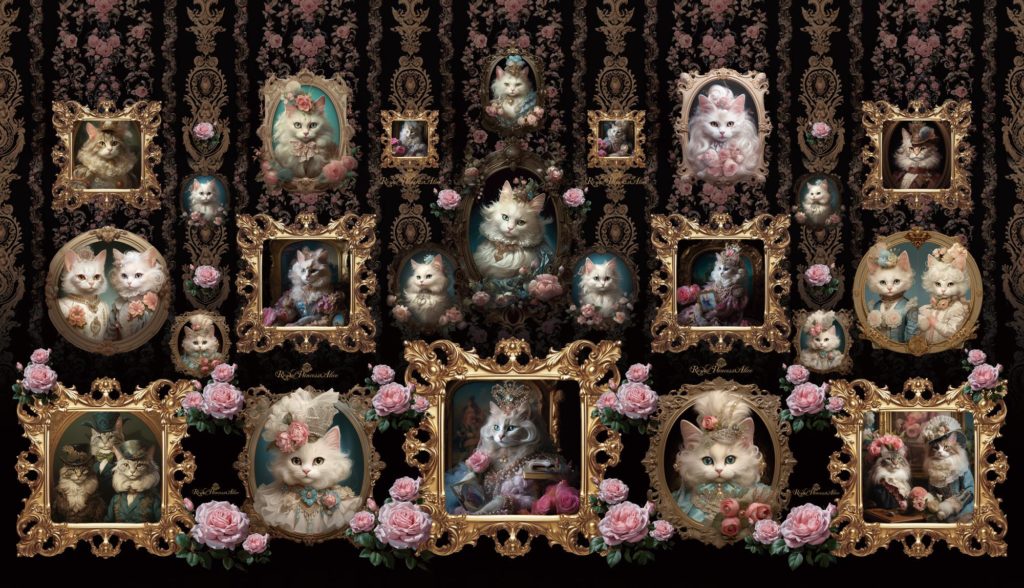

Back in November, the designer tweeted this AI generated image and wrote that she would be releasing a super gorgeous dress tomorrow, which turned out to be the marie marignantoinette series.
明日めちゃくちゃゴージャスなドレスを作ったので楽しみにしててください✨💗
— アイト&猫のルルーシュ🐱🧸🎠🎪🎟 (@KERA_Aito) November 24, 2023
その名もマリーニャントワネット🌹🐱
こちらはイメージです✨ pic.twitter.com/1qpxnA8vn1
The cat in this tweet has 5 legs and strange paws, and there are several other tells on the image, like the flowers in marie antoinette’s hair also being repeated vaguely in the background behind her shoulder, but also having those pearl drops which are above her shoulder in a way that wouldn’t make sense in life. There is also a weird spot to the left of the cat where the florals in the background melt around the frame like Salvador Dali’s clocks.



This promotional image being AI, and the lack of a collaborating artist has led to suspicion that the marie marignantoinette series is also AI.
For starters, if you put it through the AI detector Ai Or Not, it flags as AI. These detectors aren’t super great at detecting AI though, so I wouldn’t rely just on this. There are some other tells in the image. For starters, we have a level of hyper realism in the details of the cats, and an absolute abundance of light, both of which are very stylistic of things like Midjourney.



We have 3 views of this cat, and each one is slightly different. Her facial angle is slightly different. The crowns are different. The dress is vaguely different. The portrait she is holding is different. The painting behind her is different. This is very characteristic of AI generated art. A human isn’t going to paint the exact same painting 3 times but change these specific things and get 3 images that look like they could be the same image if you don’t look close enough. A human might paint the cat once and give you three different backgrounds / clothing options on the same cat, or a human might paint 3 different cats, but a human isn’t going to paint 3 totally different paintings that at a glance are identical.



Likewise, these two things are the same concept but totally different art styles. Both are pairs of rococo cats in clothes, one in light blue and one in ivory, in a round frame, but they are different as if someone described the same painting to two master artists and each gave their version. Which makes me think these are two options spit out of AI for the same prompt.


Meanwhile, these fine fellows are from a much later time period, and are in a different art style again.


And these cats looks more like actual cats…


We also have some spaces where the line between what is background and what is foreground is violated, but it’s not consistently violated in the way a human might intentionally do it.



All in all, I think at least large portions of this print are AI generated. Now, could a human have photoshopped AI images together into the final print? Yes. But I do think there was some AI involved here.
I was actually about to publish this, when I noticed they had posted an update on Insta where they wrote this:
Thank you for your extensive feedback regarding the use of AI in our recent release.
In response to this particular situation, we were recently informed about the perception of AI art by people overseas.
Using commercially approved AI software, we created a design with the help of AI, as many other companies in Japan have. With the images produced, I, as an RPA designer, redrew, rearranged, and reorganized them to complete the project.
However, I was shocked to learn today from an overseas friend that the software is known to have used artists’ work without permission or compensation in its development. Unfortunately, this is not commonly known in Japan. We deeply apologize to the international community for not researching this matter properly beforehand.
RPA greatly respects individual artists and often collaborates with them after careful discussions and appropriate compensation. RPA genuinely appreciates the talent of artists who create their own work.
As for the future, we will be showing collaborative works with several illustrators at the tea party at the beginning of the year, and we do not plan to continue to use AI to create our designs, but instead will continue to produce creations in line with our previous work.
We will continue to strive to create products that everyone can enjoy, so we look forward to your continued support.
This is in sharp contrast to souffle song, who openly admitted to using Midjourney for their print and when asked about it doubled down on trying to get positive reviews by giving items away.
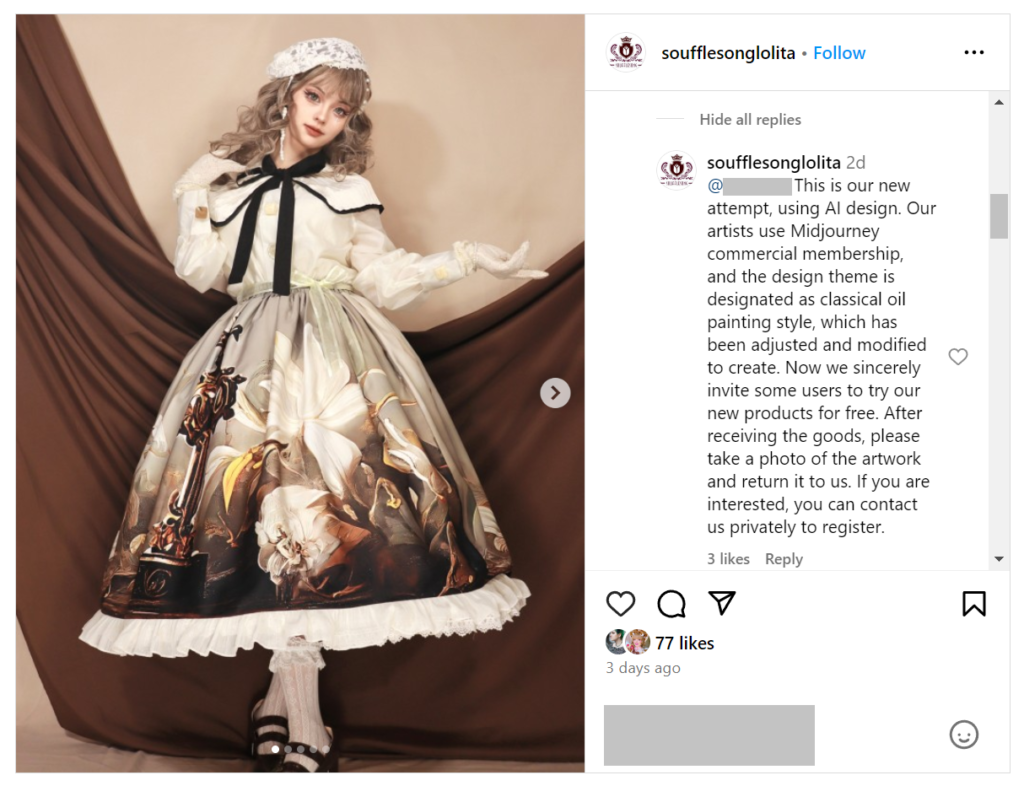
Souffle song has a history of doing controversial things, like the time they sold NFTs, or the time they made teeshirts from the specific material in question in response to an accusation of human rights violations in the supply chain of that material, and not backing down when people are unhappy with it, so I don’t really expect them to cave to the pressure of unhappy comments on social media.
All in all, I’d much rather see a print be made by an artist than by AI, even if it means using public domain images or clip art to construct a print.
What do you think?
Thanks for the write up. I was hoping you would touch more on how AI art is perceived in Japan and China. It’s promising that RPA is going to not use AI anymore. Their collabs with artists are much nicer anyway.
Wonderful post as always, very interesting read as the art landscape is changing and how that is affecting lolita fashion. I hope that we won’t see many more AI prints in the future :'(
I love that they’re deleting comments despite none of them being blatantly hateful or unreasonable. I fully expect RPA to try to use AI in the future but maybe try to use it less obviously. Those ice cream cones look absolutely AI generated.
Frequently I see people come to the conclusion that we don’t need real artists because AI can make something “better.” I this case, I thought the dress looked really poor quality and not cohesive from looking at it for about 10 seconds. I am skeptical of their statement that they redrew much of anything considering how the foreground and background are violated and how some of the cats look weirdly uncanny.
This technology should not be used for cash grabs when RPA obviously supports artists and usually uses them for design work. I seriously question RPA’s integrity after this, especially with their repeated removal of comments and refusal to admit they used this technology at first. Frankly I’m insulted they thought we wouldn’t notice, and that they thought we would buy it without questioning the poor quality art and lack of effort into the design.
Thank you for your insight on the AI training and breakdown of what this technology does and how it works as well. Great post as always.
Thanks for the very through explanation about AI and the database!
I suspect RPA designers had no idea of how AI ‘art’ is generated by using stolen data/images – most people I’ve talked to (that are outside of art bubble and outside of j-fashion bubble) also don’t understand it.
I want to honestly hope RPA will keep their partnerships with real artists for the future releases.